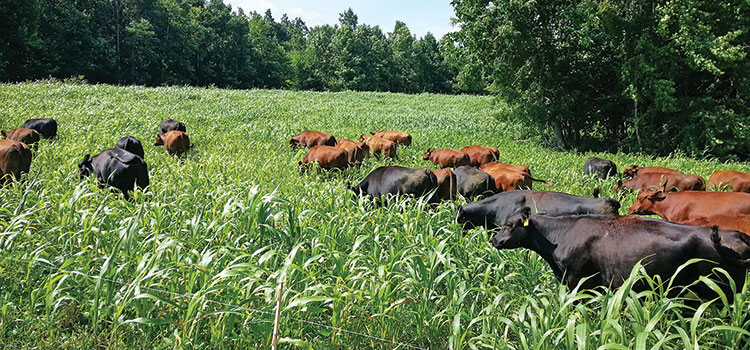
A recent conversation with North Carolina grazier and cattleman Johnny Rogers revealed that the fad is nothing new. Cover crops tend to be common annual forages, which livestock producers have been planting in pastures for decades.
Instead, the North Carolina State University Amazing Grazing program coordinator said the real reason cover crop usage is on the rise is, “We’ve realized sustainable isn’t good enough. We need to improve the soil and leave it better than we found it.”
Livestock producers are more aware of the environments they manage and, in turn, want to better understand how the systems they manage — animals, forages, and soil — work together.
Multiple roles
Rogers explained pasture-based livestock operations are perennial systems. Cover crops fit best into this scheme in four particular scenarios:
Finishing livestock on higher quality forage
Filling in forage availability gaps
Renovating worn-out perennial pastures
As a smother crop for transitioning pastures from toxic fescue to another perennial forage
This past summer, Rogers used cover crops as a smother crop in two fields on his multispecies livestock operation. Out of the nearly 300 acres he grazes, he manages approximately 29 acres in annual cover crops. In North Carolina, a region dominated by toxic tall fescue, annual cover crops give Rogers a way to transition pastures out of this undesirable forage. Plus, they serve as a nutritious grazing source for his livestock.
When considering cover crops for the first time, Rogers said to keep the principles of soil health front and center.
“Keep a living root growing in the soil year-round. Use rotational grazing. Include some diversity. Don’t disturb or till much, and don’t overgraze,” Rogers put simply.
Focusing on honing foundational strategies, such as overall grazing management, before planting the first cover crop mix is important. Once graziers have the basics down, cover crops can help in situations where soil health needs improvement or producers need alternative grazing options. For renovating pastures, in particular, annual cover crops act as a biological primer to jump-start soil health.
The cover crop types that producers choose will vary by region and climate. To select the right species and varieties, Rogers suggested you start by asking, “What is my main goal?”
“The goal might be to build soil health, provide livestock feed, or a little of both,” Rogers said.
To choose the right cover crop mix, consider the previous land use and current soil conditions of the candidate pasture.
“Think about which species and varieties will fit best for the season the forage is needed,” Rogers said.
In addition, Rogers said graziers should prepare for some challenges.
“Cover crops grow fast,” Rogers noted. “If part of the goal is to build soil health, you must be comfortable with letting some cover crops get past their peak in forage quality to increase soil residue.”
Rogers explained this practice actually feeds the soil microbial community, which he anecdotally referred to as the “microherd.”
Limit species
“There’s some value from a grazing standpoint to start out using a simpler mix,” Rogers said.
A good guideline to follow when putting together a first-time cover crop seed mix, Rogers said, is to include at least one species from each forage functional group — grasses, legumes, and brassicas. An example of a simpler mix Rogers planted in his pastures is millet, cowpeas, and a brassica hybrid.
To ensure the establishment of a successful stand in an existing perennial pasture, especially if transitioning from toxic tall fescue, Rogers recommended doing an herbicidal burndown. Grazing pastures closely will also help, but, ultimately, a clean slate gives the best establishment results.
Generally, Rogers suggested first-time cover crop graziers start out using a simple mix on a small acreage, possibly a field that needs renovating or a sacrifice area. Additionally, he said documenting the process through photos and notes, as well as recording grazing days, can help producers figure out what works best in their situation.
“Remember, you’re managing a biological system, it’s never going to be perfect,” Rogers said. “Be patient, you have to give and take with nature.”
Learn more at bit.ly/HFG-AG.
This article appeared in the January 2017 issue of Hay & Forage Grower on page 12.
Not a subscriber? Click to get the print magazine.

